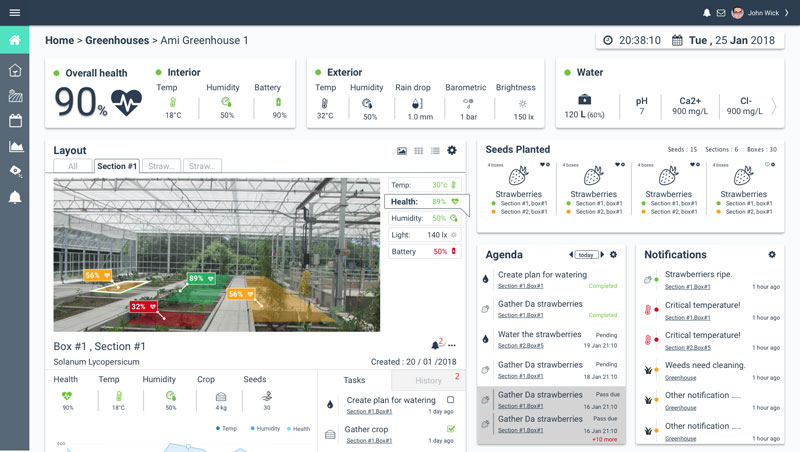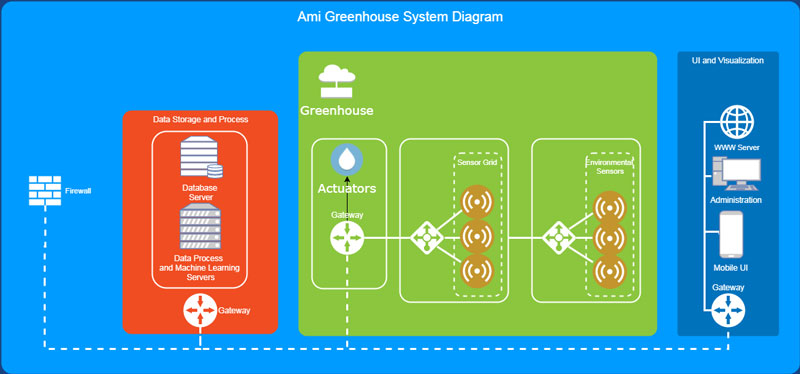by Manousos Bouloukakis, Christos Stratakis and Constantine Stephanidis (ICS-FORTH)
A unique implementation of precision agriculture in an experimental greenhouse in Crete, Greece, utilises software driven automations to boost greenhouse vegetable cultivation. The system is based on agricultural scenarios for each individual species that grows inside the greenhouse, consisting of the environmental parameters that each vegetable needs for an optimum life cycle, as well as machine learning techniques that allow the system to predict and provide information about possible hazards.
The Food and Agriculture Organisation (FAO) predicts that the Earth’s population will reach 9.6 billion by 2050, which will require a 70 % increase in food production. At the same time, two main challenges to livestock and plant production include: climate change, which is the main factor contributing to altered life cycles of plants and animals; and plant diseases, which affect the majority of food crops, reducing food production and quality. Research results have shown production losses (42% average, by comparing primary and secondary yield losses resulting from a variety of negative factors, such as plant diseases, irrigation and fertilisation misplanning, etc) on the six most important food crops worldwide. Research on precision agriculture technologies and techniques in the context of smart farming has the potential to provide technological solutions to address some of these issues.
ICS-FORTH has recently initiated AmI-Garden, a smart farming project in the framework of its Ambient Intelligence Research Programme [L1]. A small experimental IoT greenhouse has been constructed and equipped with polycarbonate cover sheets and all the necessary infrastructure and hardware (automatic window-roof opening/closing, sliding door, fan installation for heating/cooling, vegetable breeding lamps etc.). Inside the greenhouse, a network of wireless sensors is used to measure environmental conditions and parameters, such as air/soil temperature and moisture, sunlight level, soil conductivity, quality and level of chemical ions in irrigation water, etc. The sensors communicate through IoT gateways to the greenhouse’s data centre for storage and post-processing.
The system comes with pre-installed agricultural scenarios, a set of activity flows based on environmental conditions that are ideal for each plant species and are monitored in the greenhouse as explained above. The scenarios currently contain parameters to predict common diseases of the plants, as well as unexpected changes in the greenhouse’s microclimate. For example, the irrigation process is built as an agricultural scenario using data from current plant status and past data in order to establish the optimal amount of water to irrigate. The parameters of this scenario are based on specific plant breed and environmental variables.
The intelligence behind the scenarios is based on critical limits and thresholds to create cultivation rules. On top of this rule based process, event-driven activation of various automations in the greenhouse is provided, for example, automatic humidity/temperature control, soil fertilisation (hydro fusion) and precise irrigation. Various sets of raw data are produced and ingested into the system, as the life cycle of each one of the plants evolves, in order to be used as the main input for the system’s actuations based on the agricultural treatment scenarios.

Figure 1: Greenhouse Dashboard.

Figure 2: Ami Garden Diagram.
AmI Garden applies machine learning techniques to data streams such as temperature, moisture, humidity etc. Data interpretation and data mining techniques are employed to detect patterns and identify potential problems or opportunities for better plant growth (for example, specific values for moisture over a long time period can cause harm). Problem diagnosis techniques are employed to recognise characteristic symptoms (sensor communication/calibration problems, abnormal leaf wetness, water quality issues etc.) in order to develop and confirm hypotheses about possible causes.
AmI Garden’s goal is to optimise cultivation processes and the use of resources as well as the efficient use of land. IoT technologies can increase production but can also enhance the quality of agricultural products. Currently, we are in the phase of collecting, storing, processing and visualising large amounts of field measurements in order to have enough data to ingest into the process engine. After that, data modelling will be used in order to further improve the predefined agricultural scenarios and train the machine learning algorithms.
The results of the initial tests that are currently being conducted, will be expanded on a large (open air) land field and larger greenhouses in order to verify the system’s scalability and ensure a strong deployment potential.
Link:
[L1] http://ami.ics.forth.gr/
References:
[1] S. Wolfert, et al.: “Big Data in Smart Farming – A review”, Agricultural Systems, 153, 69-80. doi:10.1016/j.agsy.2017.01.023
[2] Agriculture. Special Issue “The Impact of Plant Disease on Food Security”, 2012. Retrieved from https://kwz.me/hbG
[3] U. Cortes., et al.: “Artificial Intelligence and Environmental Decision Support Systems”, Applied Intelligence 13, 77–91, 2000.
Please contact:
Constantine Stephanidis
ICS-FORTH, Greece
+30 2810 391741











